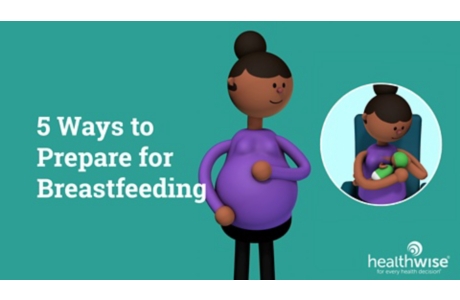Overview
Feeding a baby is an important concern for parents. Experts recommend feeding your baby only breast milk for about 6 months. They also support breastfeeding for 2 years or longer.footnote 1 But your baby benefits from any amount of time that you breastfeed. Try to breastfeed for as long as it works for you and your baby.
If you are unable to or choose not to breastfeed, feed your baby iron-fortified infant formula. Most babies younger than 6 months of age can get all the nutrition and fluid they need from breast milk or infant formula. But if you are breastfeeding, your baby may also need a vitamin D supplement.
Starting around 6 months of age, your baby needs solid foods along with breast milk or formula. Some babies may be ready for solid foods at 4 or 5 months. Ask your doctor when you can start feeding your baby solid foods. And if a family member has food allergies, ask whether and how to start foods that might cause allergies. Most allergic reactions in children are caused by eggs, milk, wheat, soy, and peanuts.
Weaning is the process of switching your baby from breastfeeding to bottle-feeding, or from a breast or bottle to a cup or solid foods. Weaning usually works best when it is done gradually over several weeks, months, or even longer. There is no right or wrong time to wean. It depends on how ready you and your baby are to start.
How can you feed your infant during the first year?
Babies ages 1 month to 5 months
- Feed your baby breast milk or formula whenever your infant shows signs of hunger. By 2 months, most babies have a set feeding routine. But your baby's routine may change at times, such as during growth spurts when your baby may be hungry more often. At around 3 months of age, your baby may breastfeed less often. That's because your baby is able to drink more milk at one time. Your milk supply will naturally increase as your baby needs more milk.
- If you're breastfeeding, your baby may need a vitamin D supplement. Ask your doctor if you should give your baby a vitamin D supplement and for how long.
- Do not give any milk other than breast milk or infant formula until your baby is 1 year of age. Cow's milk, goat's milk, and soy milk do not have the nutrients that very young babies need to grow and develop properly. Cow and goat milk are very hard for young babies to digest.
Babies ages 6 months to 12 months
- Around 6 months, you can begin to add other foods besides breast milk or infant formula to your baby's diet.
- Start with very soft foods, such as baby cereal. Iron-fortified, single-grain baby cereals are a good choice.
- Introduce one new food at a time. This can help you know if your baby has an allergy to a certain food. You can introduce a new food every 3 to 5 days.
- When giving solid foods, look for signs that your baby is still hungry or is full. Don't persist if your baby isn't interested in or doesn't like the food.
- If you're breastfeeding, keep offering your baby breast milk as a part of your baby's diet. Experts support breastfeeding for 2 years or longer.footnote 2 Breastfeed for as long as it works for you and your baby. If you are using formula, keep offering formula as part of your baby's diet until your baby is at least 1 year old.
- If you feel that you and your baby are ready, these tips may help you wean your baby from the breast to a cup or bottle.
- Try letting your baby drink from a cup. If your baby is not ready, you can start by switching to a bottle.
- Slowly reduce the number of times you breastfeed each day.
- Each week, choose one more breastfeeding time to replace or shorten.
- Offer the cup or bottle before you breastfeed or between breastfeedings. You can use breast milk pumped from your breast. Or you can use formula.
- If your doctor thinks your baby might be at risk for a peanut allergy, ask your doctor about introducing peanut products. There may be a way to prevent peanut allergies.
What are signs that your baby has had enough to eat?
Babies give cues during feeding that can help you know when your baby has had enough to eat.
- A baby who is getting full during a feeding will take longer pauses between sucking.
- A baby who is full will turn away from the breast or bottle and not want to suck.
References
Citations
- American Academy of Pediatrics (2022). Policy statement: Breastfeeding and the use of human milk. Pediatrics, 125(1): 1–15. DOI: 10.1542/peds.2022-057988. Accessed July 18, 2022.
- American Academy of Pediatrics (2022). Policy statement: Breastfeeding and the use of human milk. Pediatrics, 125(1): 1–15. DOI: 10.1542/peds.2022-057988. Accessed July 18, 2022.
Credits
Current as of: October 24, 2023
Author: Healthwise Staff
Clinical Review Board
All Healthwise education is reviewed by a team that includes physicians, nurses, advanced practitioners, registered dieticians, and other healthcare professionals.
Current as of: October 24, 2023
Author: Healthwise Staff
Clinical Review Board
All Healthwise education is reviewed by a team that includes physicians, nurses, advanced practitioners, registered dieticians, and other healthcare professionals.



